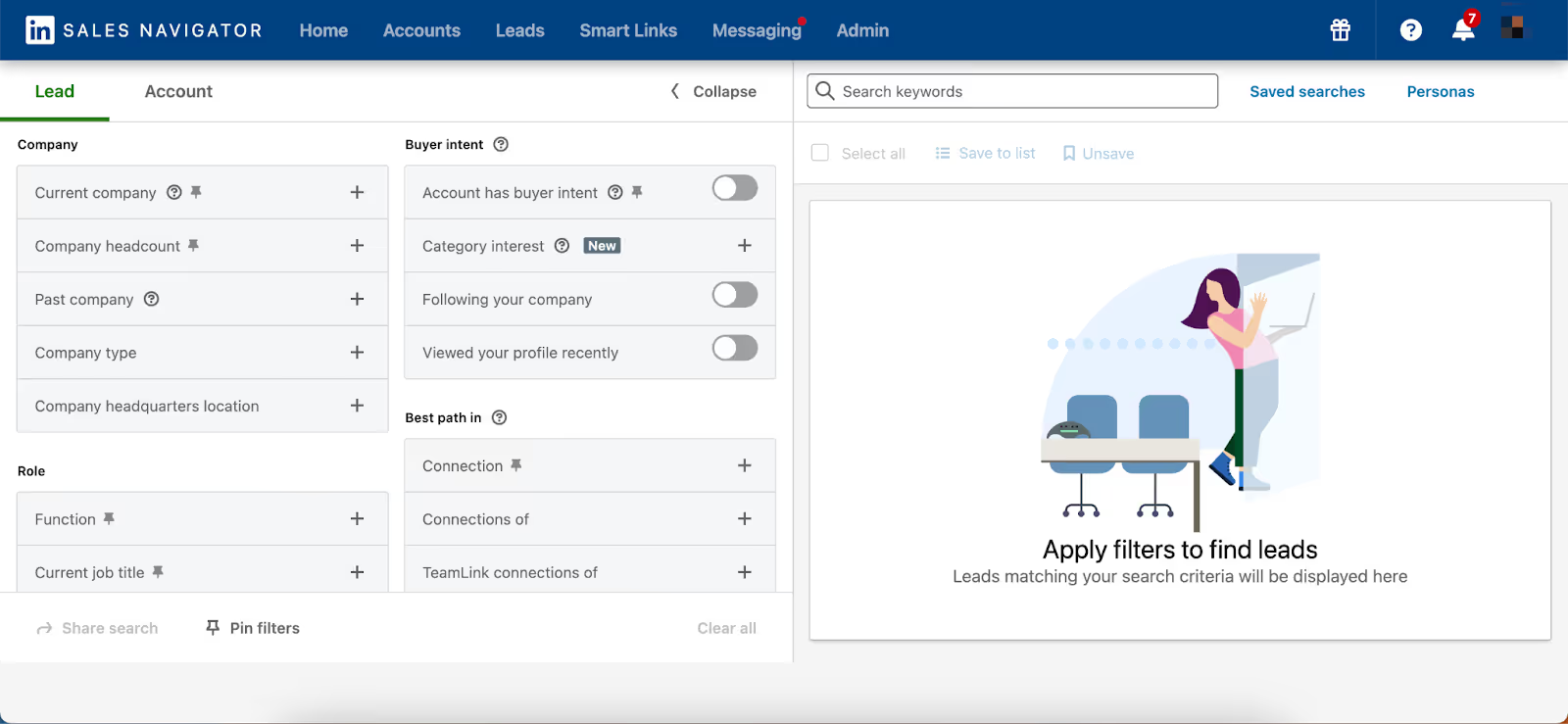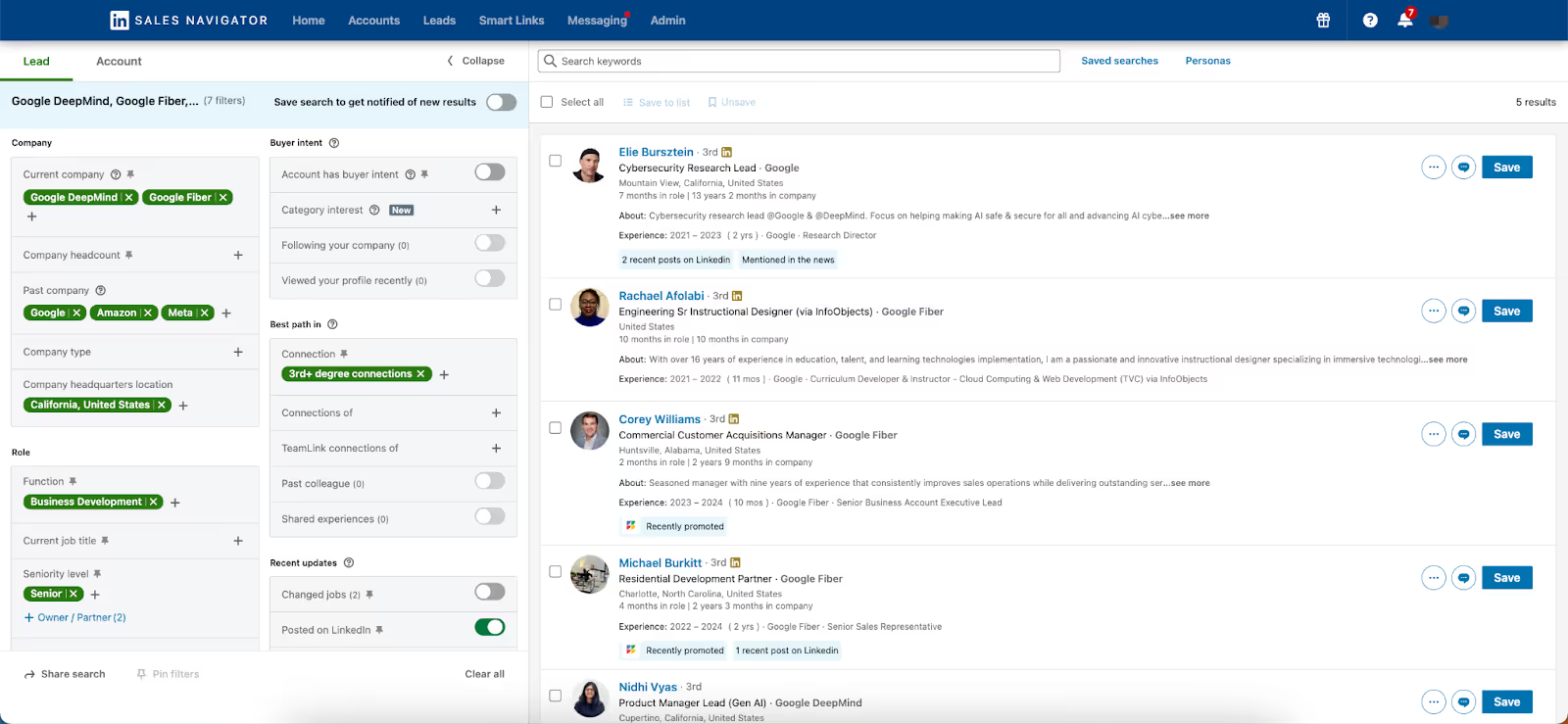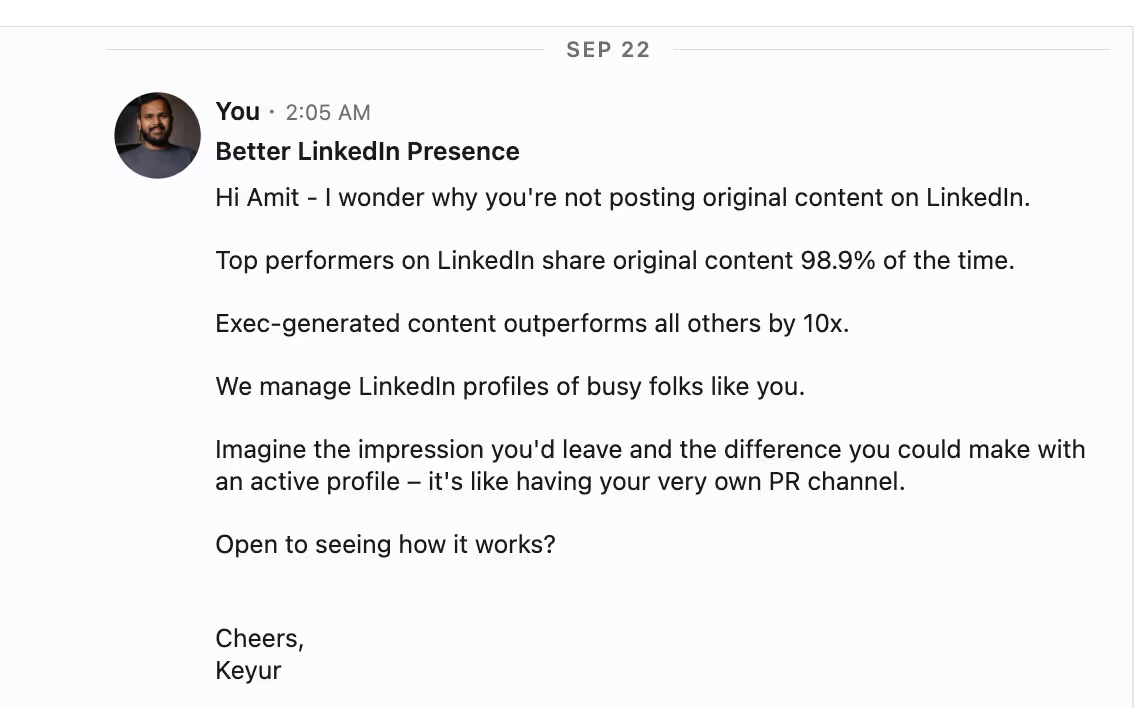
LinkedIn remains the largest and fastest-growing professional networking platform with over a billion active users that include individuals from CEOs to interns. This significant growth reflects LinkedIn's evolution from a mere job discovery platform to a vital tool for network expansion and professional connectivity.
Networking on LinkedIn goes beyond simple connections; it is about strategically building relationships that foster both business and personal growth. However, the challenge lies in standing out in an already crowded marketplace.
How do you ensure that your message is not only seen but also gets a positive response?
The key is in crafting cold messages that are not only personalized but also clearly aligned with the interests and needs of the recipients.
This involves a deep understanding of your target audience, the effective use of LinkedIn’s lead generation tools, and a strategic approach to outreach.
Throughout this blog post, we will delve into the various steps that will help you perfect your cold messaging technique. By mastering the art of the LinkedIn cold message, you can transform the way you network, opening up a world of opportunities that could redefine your professional landscape.
What Is Cold Messaging on LinkedIn?
"Cold messaging" refers to the practice of sending a professional message to someone on a digital platform without any prior intimation, connection, familiarity, or context. Typically, these messages are used to sell a product or service, inquire about opportunities, or initiate a professional conversation between two parties who have not previously interacted.
On LinkedIn, cold messaging is a common tactic employed by users from various professional backgrounds to achieve diverse objectives, such as:
- Cold Messaging for Business Marketing: Businesses utilize LinkedIn cold messaging to directly engage their Ideal Customer Profile (ICP) contacts, aiming to market new products or services efficiently. This direct marketing approach allows companies to personalize messages, ensuring they reach a highly targeted audience. An effective cold message for business marketing should highlight the unique benefits or features of the product or service, addressing directly how it solves specific problems or improves the recipient’s business/life. The message should be concise, attention-grabbing, and tailored to reflect an understanding of the recipient’s industry or personal business needs.
- Startup Recruitment Through Cold Messaging: Startups often rely on cold messaging to scout and recruit top talent who may be looking for new career opportunities. This approach allows startups to communicate directly with potential candidates, presenting the unique opportunities and benefits of joining their growing team. It’s an essential tool for startups aiming to attract skilled individuals in a competitive job market. A successful cold message from a startup to a potential candidate should not only focus on the job description but also the culture and vision of the startup. It should make a compelling case for why the candidate should consider a career shift, emphasizing how their specific skills and aspirations align. Personalization is crucial, as it demonstrates genuine interest in the candidate’s career and not just their fit for the role.
- CEOs and Targeted Networking: For CEOs and other senior executives, cold messaging is a strategic means of expanding their professional network with other thought leaders and potential business partners. This form of networking is targeted, with a focus on establishing meaningful connections that can lead to mutually beneficial collaborations. An effective cold message for CEOs should start with a brief introduction of themselves and their company, followed by a clear explanation of why they are reaching out to the specific individual. The message should propose a clear potential benefit or point of interest, such as a shared business goal or a recent industry development that might be of mutual concern.
- Job Seekers and Cold Messaging: For job seekers, especially those in highly competitive markets, cold messaging can serve as a direct conduit to decision-makers, bypassing traditional application channels. This proactive approach puts their qualifications and enthusiasm directly in the spotlight, increasing their visibility among potential employers. An effective cold message from a job seeker should clearly depict why they are an ideal fit for the position or the company. The message should detail relevant skills and experiences and express a strong interest in the company’s values and mission. Distinguishing themselves from the competition, job seekers should also convey a personal connection or insight into the company, showing that their interest is well-researched and genuine.
How Is Cold Messaging Better Than Email Outreach?
Statistics reveal a compelling narrative: LinkedIn InMails enjoy up to a 25% response rate, while emails generally see only a 10% response rate.
This contrast is because of several distinct advantages that LinkedIn's InMail system offers over traditional email outreach. Understanding these differences can help you refine your approach to professional communications, ensuring that your outreach efforts are more personalized, visible, and effective.
- Enhanced Personalization: LinkedIn InMails are designed to help with a higher degree of personalization. When recipients receive an InMail, it's clear that the sender has chosen them specifically, rather than sending out a generic message to a crowd. This sense of individual attention makes the recipient feel special and more inclined to engage. In contrast, cold emails often feel like just another number in a bulk marketing campaign. People generally prefer feeling singled out for a unique opportunity rather than being one of many, which is why personalized InMails tend to generate more interest and a higher likelihood of a response.
- Perceived Value and Commitment: InMails come with a cost, which signals a sender's commitment and seriousness about the engagement. This investment suggests that the sender values the potential connection highly enough to spend resources on it, enhancing the perceived value of the message. This is not usually the case with emails, which can be sent in large quantities without incurring any cost, potentially diminishing their perceived importance. The financial aspect of sending InMails acts as a filter, ensuring that only those messages that are truly considered worthwhile by the sender are transmitted, which increases effectiveness.
- Increased Visibility: Unlike emails that can easily be lost in spam folders or missed among hundreds of daily emails, InMails are guaranteed to reach the recipient’s LinkedIn inbox. This direct delivery to a professional's LinkedIn account significantly increases the chances that the message will be read. LinkedIn's messaging system also notifies users when they receive InMails, adding an additional layer of visibility that emails lack, further enhancing the likelihood of engagement.
- Transparency and Professional Relevance: The transparency of LinkedIn as a platform adds a layer of trust to InMails that emails often cannot match. Recipients can immediately view the sender's profile, verify their professional standing, and assess the relevance of the message. This ability to quickly validate the sender’s professional identity and build immediate trust. Cold emails, lacking this level of transparency, can often appear suspicious or irrelevant, making them less effective in establishing a trustworthy communication channel.
Step-By-Step Cold Messaging on LinkedIn
To be able to maximize the cold messaging facility offered by LinkedIn, you need LinkedIn Premium, which will grant access to Sales Navigator.
Step 1: Create a Leads List
On your Sales Navigator dashboard, you will see a handful of filters. If you set them to point toward the exact kind of people that you wish to reach out to, Sales Navigator will generate a list of prospects and show you details like their names, designations, companies, headlines, About sections, recent posts, degree of connection with you, and recent job updates. Add them to a custom list.


Step 2: Prepare a Subject Line
Choose the first relevant profile to message. A LinkedIn InMail requires a subject line and has a body that ends with a signature. Your subject line has to be the most creative part of your InMail – it determines whether your message will even be opened. Personalize it and include the recipient’s name. Add context but don’t sell.
For example, if you’re reaching out to pitch your financial advisory services, your subject line can be: “James, your revenue can be 300% higher.”
If you want to talk to someone you’re looking to hire, your line can be: “Emma, you could be our senior software engineer.”
If you wish to sell someone your course, it can be: “Looking for life-changing fitness advice?”
Step 3: Write the Message
Crafting the perfect LinkedIn cold message requires precision and a clear structure. Start by introducing yourself and explaining how you came to know of them, perhaps through a mutual contact. It's also important to acknowledge their work—this not only shows genuine interest but also establishes a connection.
Briefly mention your services and clearly showcase the benefits they stand to gain by working with you. Always include a direct call to action (CTA); provide a simple way for them to reach out, like a booking link, which respects their time.
Ensure your message is concise and relevant—C-level executives highly value their time. Avoid overstepping by criticizing their current operations just to highlight how your services could help; this can come off as disrespectful. Instead, focus on how your offerings are beneficial.
Step 4: Follow Up
You can feel free to hit them up twice in all: Once a few days after your InMail and the second time after a fortnight. Remind them politely, don’t demand an answer. CEOs are very busy people so it is possible that your InMail simply slipped their mind.
Serve them everything on a platter. If you’re following up, resend the booking link or brochure website. They value convenience.
Don’t follow up more. If it crosses the edge of annoyance, you’ll end up losing not just a connection but also your reputation in their circle.
3 Cold Messaging Templates
When you send messages on LinkedIn to their Ideal Customer Profiles (ICPs), the approach must be strategic and personalized. The message should start by acknowledging the recipient's position, subtly flattering their professional status while establishing a common ground.
This not only personalizes the message but also shows a genuine interest in the recipient’s work. It's crucial that the message then transitions into a value proposition that is relevant to the recipient's interests.
This approach is direct and respects the recipient's time, while clearly stating the purpose of the outreach. The tone should remain professional yet approachable, reflecting your position but also your willingness to engage on a level that respects the recipient’s expertise and time.
Two examples of outbound messages that a CEO sent to ICPs.
1. Key Points to note from the example below:
- Engagement: The message directly addresses the recipient by name and references specific work. This demonstrates genuine interest.
- Acknowledgement: It appreciates the recipient’s profile visit and content, setting a positive tone for further interactions.
- Constructive Feedback: The sender suggests enhancements to LinkedIn profile sections to get them interested.
- Link to Relevant Work: An overview included in the message showcases the sender’s work, adding credibility.

2. Key Points to note from the example below:
- Personalization: Start with a specific observation about their current LinkedIn activities or lack thereof.
- Value Proposition: Clearly state how your service can benefit them, backed by relevant statistics or success stories.
- Call to Action: Encourage a follow-up action, such as a meeting or a phone call, to discuss potential collaboration.

An example of an outbound message that a CEO accepts from another party.
1. Key points to note from the example below:
- Personal Connection: The sender mentions a mutual connection who has facilitated the introduction, providing a trusted link.
- Shared Interest: The sender identifies a shared interest or sector, specifically mentioning their involvement in A&I (presumably a field or industry), which helps establish common ground.
- Acknowledgement of Reputation: The sender notes that Justin Welsh speaks highly of the recipient, Keyur, which not only flatters but also adds a layer of credibility and intrigue to the outreach.
- Future Interactions: The sender expresses enthusiasm about seeing what Keyur creates, indicating an interest in Keyur’s work. This opens the door for future interactions and potential collaboration.

Conclusion
Writing the perfect LinkedIn cold message is all about being clear, concise, and respectful. Introduce yourself professionally, commend their work, explain how you can help, and always include a direct call to action. This straightforward approach saves time and builds trust, making it easier for C-level executives to see the value in connecting with you.
If you're looking to utilize the full potential of LinkedIn and improve your professional presence, we're here to help. We specialize in partnering with executives to use LinkedIn as a powerful tool for reputation-driven business growth. To discuss LinkedIn branding for your profile, feel free to schedule a call with us!
Frequently Asked Questions
Is it rude to send messages to people that you aren’t connected to?
Sending messages to individuals you aren’t connected to on LinkedIn isn’t rude; it’s a common practice on this professional networking app. However, it’s important to ensure that your messages are personalized and respectful. They must provide clear value to the recipient by making the right impression.
Do cold messaging techniques still work for B2B leads?
Yes, cold messaging techniques are effective for B2B leads, as long as they are well-researched and personalized. Addressing specific industry needs, opportunities and challenges can engage potential clients.
To which designation should I send cold messages?
Cold messages should be directed at individuals who are key decision-makers or influencers within an organization. This often includes titles such as Managers, Directors, VPs, and C-level executives.
When is the best time to send cold messages?
The best time to send LinkedIn cold messages is during business hours, particularly mid-morning to the afternoon on weekdays. This improves the likelihood of a response as professionals are more likely to be active on LinkedIn during these times.
How many InMails do I get with the package?
The number of InMails you receive depends on the specific LinkedIn subscription package you choose. For instance, LinkedIn Premium Business gives you 15 InMails per month, while Sales Navigator Professional offers 20 InMails per month. The Sales Navigator Team and Enterprise editions provide even more, catering to higher volume needs.
How do I get Sales Navigator?
To get LinkedIn Sales Navigator, visit LinkedIn’s Sales Solutions page and select the Sales Navigator option. You will have the choice between different tiers, such as Professional, Team, and Enterprise, each offering various features and InMail capacities.
How can I get more InMails after I exhaust my weekly quota?
If you run out of your weekly InMail quota, you can purchase additional InMails directly from LinkedIn. Alternatively, consider upgrading your subscription to a higher tier that offers more InMails per month, suitable for users with higher outreach needs.
Why is nobody replying to my cold messages?
If you're not receiving replies to your cold messages, it could be due to a lack of personalization or relevance in the messages you're sending. Ensure your messages clearly address the recipient's interests or needs and include a compelling reason for them to respond. Also, double-check that your messages are free of errors and are professionally composed.
Can I automate my cold messaging process?
Yes, you can automate your cold messaging process using various third-party LinkedIn automation tools. However, use caution as automation can sometimes lead to less personalized messages and may violate LinkedIn's terms of service. It's crucial to maintain a balance between efficiency and personal touch.
How many times is it appropriate to follow up
Typically, it’s appropriate to follow up twice after your initial message if you haven’t received a response. The first follow-up can be a gentle reminder, and the second—a last attempt to elicit a response. Always space out your follow-ups to avoid appearing pushy.
Can I block someone on LinkedIn?
Yes, LinkedIn allows you to block people. If someone has made you uncomfortable, shared hateful content, or for any other reason, you can block them on LinkedIn to protect your privacy.
Do follow-up messages consume the InMail quota?
Yes, follow-up messages do consume your InMail quota. Each message sent, whether it's an initial outreach or a follow-up, counts against the number of InMails allotted in your LinkedIn subscription.
How to Write the Perfect LinkedIn Cold Message
LinkedIn cold messaging is a powerful way to reach decision-makers, clients, and potential partners directly. Unlike email, InMails offer higher response rates, better visibility, and built-in trust thanks to LinkedIn’s transparent platform. Whether you’re a business, startup, job seeker, or CEO, the right message can open doors to meaningful opportunities. By applying clear, concise, and personalized strategies, you can ensure your cold messages make a real impact. With the right balance of research, tone, and follow-up, LinkedIn cold messaging shifts from a simple outreach tactic into a lasting driver of professional growth and opportunity.
Insights Hub

LinkedIn Sales Navigator: How to Generate Leads in 2025
.avif)
How to Cancel Your LinkedIn Premium Subscription?
.avif)
6 Proven Tips to Increase LinkedIn Connections in 2025
Want to explore how this applies to your brand?
Let’s talk.




